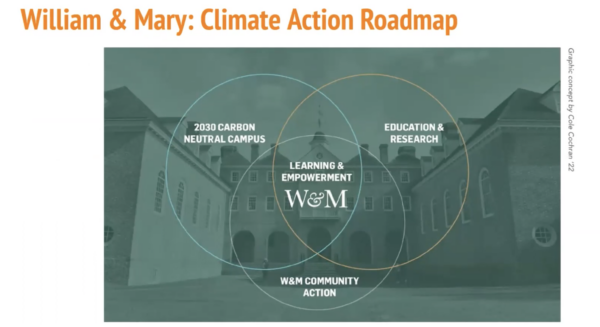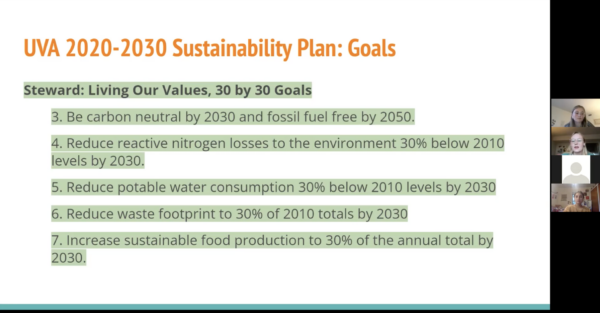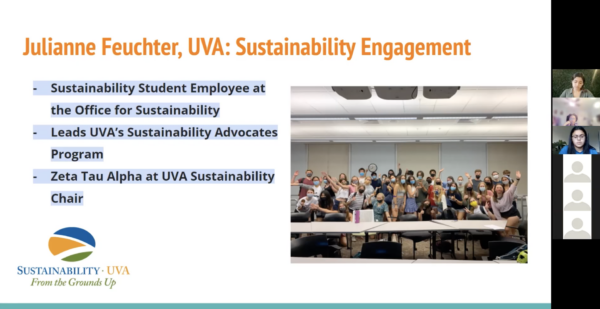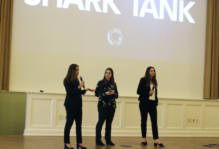William & Mary and UVA Host Joint Climate Action Talk
On Tuesday, April 12th, student representatives from William & Mary and the University of Virginia met virtually to host a Climate Action Talk. The talk was held as a part of the W&M+UVA Climate Action Partnership, released in 2019 with the goal of making both institutions carbon neutral by 2030. As a result of the partnership, the W&M+UVA Climate Action Committee was established. This is a team of students, faculty, and staff dedicated to creating connections and hosting initiatives toward carbon neutrality.
The talk was hosted by UVA students Morgan Foster’22 & Nora Raleigh as well as William & Mary students Madeline Bertagnolli ’22 & Olivia Wachob ’23. Foster opened the talk by discussing three main areas of focus of the partnership: First, sharing information and resources on climate action planning and implementation; second, outreach and engagement opportunities within and across both universities; third, collaboration with other institutions across Virginia.
Wachob and Bertagnolli then introduced William & Mary’s Climate Action Roadmap, which illustrates a three-faceted integrative approach focused on carbon neutrality goals, community action, and education & research. Each facet contains six steps, many of which involve strategies to create sustainable options for living, dining, and overall campus function. The carbon neutrality facet calls for 100% renewable energy and a 15% building energy reduction, while the community action outlines goals ranging from procuring more sustainable, plant-forward dining options to greening study abroad programs.
Raleigh introduced UVA’s sustainability plan, which contains four facets, including governance & collaboration, community & service, 30 by 30 goals, and curriculum & research. Governance & collaboration focus broadly on economic, environmental, and equity considerations to be implemented across the university, while the community & service aspect focuses on sustainable community engagement. The 30 by 30 goals are the most concrete, including being fossil fuel-free by 2050 and reducing both potable water consumption and total waste footprint by 30% below 2010 levels.
After the discussion of goals, a student speaker from each of the universities spoke on current issues and actions in sustainability. From William & Mary, Neel Simpson ’22 presented on steps William & Mary students — and anyone — can take to engage in sustainable practices. Simpson began by outlining three lenses for sustainability – environmental, social, and economic. Through these lenses, Simpson explained the ins and outs of reducing, reusing, and recycling. While reducing and reusing are intuitive, recycling is a complex process in which materials must be separated into different categories, and contaminated materials may not be recycled at all. Simpson also covered the intricacies of composting, touching on the two types of organic matter – greens such as coffee grounds and veggie scraps, and browns such as wood chips and tree bark – and why each are crucial to producing fresh, nutrient-rich soil and reducing atmospheric methane output. Additionally, Simpson promoted the benefits of a plant-forward diet, which can reduce emissions and water waste.
The student speaker from UVA was Julianne Feuchter ’24, who discussed her work in UVA’s Office of Sustainability and why the Office’s work is so crucial to continued climate action efforts. Feuchter leads the Sustainability Advocates Program, a group of students who connects UVA students with resources for engagement with sustainability through student-led projects. Feuchter spoke about the Sustainability Advocates Program’s carbon neutrality group, which led a project to convert an iconic UVA light show to renewable energy. Another initiative Feuchter touched on was the zero-waste trainings for clubs and Greek life organizations on making their events as green as possible.
The entirely student-led talk demonstrated the W&M+UVA Climate Action Committee’s dedication to not only reaching carbon neutrality by 2030, but also to creating equitable opportunities for both university communities to engage in conversations and actions centered on sustainability and climate action. Their specific goals and robust strategies for making carbon neutrality a community-based initiative served as a powerful reminder of not only the time and effort being put into the 2030 carbon neutrality goal, but of the hope for a better climate future that the partnership stands for.







No comments.
Comments are currently closed. Comments are closed on all posts older than one year, and for those in our archive.